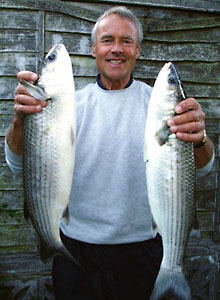|
A few weeks ago I wrote about a tremendous
tussle with a large Grey Mullet, light line fishing on the upper
Dart. After a monumental fight I landed a beautiful specimen Mullet,
very neatly foul-hooked through the shoulder, which explained why it
had run off like an express train!!! It was the only bite in a very
long and cold session.
Fast forward two weeks, and again I'm fishing the
upper regions of the river. The weather has been dreadful in the
preceding days, cold, windy and very wet. In fact the weather seems
to have got worse and worse since the B.B.C. introduced their new "dumbed
down" forecasts, so I'm blaming it all on them!!
 |
Mike Bailey
of Brixham SAC
proudly holds a brace
of River Dart Mullet
6 lbs 3 ozs 12 dr
&
4 lbs 3 ozs 12dr
brought back for weigh-in
and returned alive
June 2005
Photo courtesy
of Mike Bailey |
Fishing for Mullet is so different at every
location that you try. What works well in the open sea is not as
effective in the harbours and marinas, and the South Devon river
systems all have their own characteristics. Methods which work well
on the Dart don't always translate into success on nearby rivers such
as the Teign.
Even ten miles from the sea, the Dart has deep
tidal pools which can be fished including at low water. Late
spring/early summer sees shoals of fish grazing like flocks of sheep
on the soft and abundant new weed growth. Happily, they can be weaned
off this by a judicious use of groundbait, ( usually mashed up
breadcrumbs, and a stealthy approach, as the water is crystal clear
and very shallow.)
Anyway, back to the fishing! Yet again torrents of
peaty flood water were foaming down the river as I set up. In such
clear water, light line is an absolute must. Take your choice. Many
favour fluoro-carbon but for me it is has a slightly stiff feel, and I
always use Berkely Trilene XL which is very reliable, fine diameter,
and has a soft feel to it. Mullet "nose" the bait a lot and I think
this softness makes them more liable to take the bait in. Hooks need
to be strong, and with bread baits sizes in the range 6, 8 and 10
cover most of your needs.
The first pool I set up in was only two feet deep
when I started but the tide was starting to push in rapidly. I use a
"chubber|" type float because the current can flow hard at times, so
it's necessary to carry a decent amount of shot to keep the bait near
to the bottom, (shotting patterns need changing during the session and
a plummet is needed so that you can make the constant adjustments to
the rise and fall of the water levels).
Enough of the technical stuff, let's get down to
the fishing itself. As I set up the steady drizzle turned to heavy
rain and then by degrees to a torrent. The rain danced off the rod
and the surface turned to a white froth of cascading water and
bubbles. My lightweight waterproofs were in for a testing and I was
going to end the day completely saturated!
I flicked a bait of soft paste into the shallow
water over my groundbait; the float settled, bobbed and disappeared.
I struck firmly but missed the bite, but the fish were there! The rain
came down in a deluge but bite followed bite. You miss a lot of bites
mulleting but it was only a matter of time before I was well hooked
into a very angry and powerful Mullet which stormed off in fantastic
runs in such shallow water. Some time later it was safely netted, ( a
fish of 3lb. 12oz.) and gently returned, well away from the swim I was
fishing, so as not to spook the rest of the shoal.
Usually, catching a fish spells the end of the
action for a while, but not today. The rain continued to pound down
and bite followed bite. Many were missed and a couple hooked and then
lost, but every so often a fish was hooked and after a great fight
landed.
A good day on the Dart is usually measured as two
or three fish, and that's often by moving to different swims, but
today was completely crazy! Fish followed fish, including a number
over 4lb. and a comparative rarity on bread, a thin-lipped mullet.
For the next three hours the action was
continuous; the harder the rain came down the more the fish bit. And
then the icing on the cake. At just after high tide, the float dipped
and sank away. As soon as I hooked the fish I knew I had to be
careful. By now the water was much deeper and this fish went down and
started to bang violently in frantic and powerful head-shaking
lunges. Every so often it would go off on a shattering run, then hold
down deep again. Slowly, the fish tired, but it was by no means
finished. Big mullet just don't know when they're beaten and on very
light gear you have to be careful or you'll snap up.
Again and again it rolled by the side only to
disappear in an instance, but by now it was a question of patience and
playing it out. 20 to 25 minutes after hooking, a great long lean
mullet was in the net, a magnificent specimen which was to weigh 6 lb
3oz 12 drms. It was end of the session and the fish had gone, but
what a day, with eleven fish taken and seven over 3lb 12 oz One of
the best mullet sessions I've ever experienced, with continuous bites
and quality fish.
It would be futile to try to analyse why it was so
good. I fished a couple of days before with modest results and tried
a couple of days later in very similar conditions, and was completely
biteless!
And yet, on reflection, isn't that what makes
angling so appealing. You get it right some days and think you've
cracked it, them the next time your day goes pear-shaped and nothing
works out.
Mullet!- infuriating, exasperating,
unpredictable!!! One of the hardest and shyest of fish to catch at
times and pound for pound surely one of the finest sporting fish
you'll ever hook. Me, I wouldn't want to change anything about them.
You've guessed it. I'm off to try and catch some more, this time on
the River Teign. But that's another story for another day.
|

